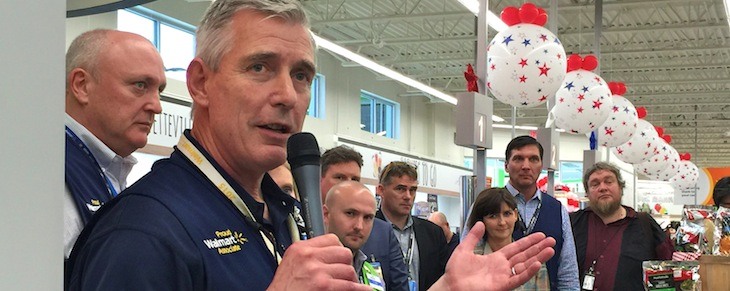Walmart U.S. execs share insights on the division’s turnaround
by February 22, 2017 6:50 pm 2,720 views

Greg Foran, Walmart U.S. CEO, during an event held in conjunction with the 2017 shareholders meeting.
The recent quarter was good for Walmart U.S., but the CEO of the division still has a long list of improvements he wants to make within the retailer’s flagship unit.
Walmart U.S. put up its best same-store sales numbers in more than four years on Tuesday (Feb. 21). The retail giant posted solid fourth quarter numbers in part because of increased store traffic as well as growing e-commerce growth. The devil of retail is in the details, according to Walmart U.S. CEO Greg Foran, who took control of the U.S. store fleet in July 2014. Foran told the media at that time he would turn the division around one store at a time.
Walmart grew its fourth quarter U.S. business by 2.8% with a sales comp of 1.8% led by 1.4% hike in store traffic and slightly higher basket totals. While 1.8% is not an excellent comp sales number, it was better than what the majority of competitors reported for the same period, and an indication that Foran has turned the majority of stores around during his 2.5 years at the helm.
Karen Short, retail analyst at Barclays said Tuesday, “Walmart has turned stores around. If you go into a Walmart store today it doesn’t look or feel like it did five years ago, Foran’s plan is apparently working.”
Short is overweight on Wal-Mart Stores with a target price of $87. She is not alone in that sentiment. Bank of America analyst Robert Ohmes upgraded Wal-Mart stock on Wednesday (Feb. 22), saying, “Wal-Mart is embarking on a period of sustainable 20-30% e-commerce growth.” He expects the stock to rally more than 20% in the next 12 months.
Foran and his executive team recently spoke to suppliers about the retailer’s plans to grow sales at the Supplier Forum held Feb. 15-16 in Bentonville. (Talk Business & Politics received a transcript from that event which is the basis for the rest of this report.)
He said the retailer is doubling down on its effort to be the low cost leader amid staunch grocery competition. Kroger, Public, H-E-B and other grocery giants present major competition to Walmart U.S., but Foran told suppliers that focus on price and store execution were his biggest priorities this year. Foran told suppliers that price leadership — every day low prices — is not just about bricks and mortar as he said Walmart U.S. plans to align in-store pricing with online. He said Walmart will continue to be a “house of brands” while also striving to improve private label offerings. Aside from low prices, Foran said saving people time is also important. He said the grocery pickup is gaining momentum and the retailer will stick to this plan because it’s working.
Foran said when online grocery comes to a store, it lifts the store’s overall performance. Walmart U.S. finished last year with 600 stores offering grocery pickup. Foran said 500 more will be added this year. Another big initiative he mentioned was to align in-store inventories and online inventories so distribution centers are able to fulfill more online orders.
He also said the number of same-day pick up items for general merchandise is being increased, which is a benefit for consumers given the number of stores in the proximity of consumers homes and places of employment. Foran also hintend that Walmart plans to roll out new ways to pass savings on to customers this year. He did not say if Savings Catcher was again being tweaked or if there is another plan in place such as the “basket pricing” that is available on Jet.com and also being added to Walmart.com.
He did say “basket economics is where we live.”
Judith McKenna, COO for Walmart U.S., told suppliers the company continues to empower its workforce and adopt technologies into store operations. For instance a new store located in the Houston suburb of The Woodlands, Texas, has more than 100 touch screens located throughout the store to deliver endless aisle experience for shoppers in that store.
The three-year vision Walmart U.S. has with the “endless aisle” concept requires they complete merging of backend inventory systems between distribution centers and stores. It’s a very complicated process, but one the retailer said it has begun and hopes to finish in three years. In that concept, a customer who walks through a store and sees an item they want may select and pay for it on a touchscreen and have it delivered at their home at their convenience.
McKenna said store operators will have new technology that shows them in real time the status of items at the shelf. This new tool known as On-Shelf Customer Availability should help reduce inventory errors that can lead to out-of-stocks and perhaps costly fines to suppliers when the issue is more likely related to miscounting or not taking inventory counts frequent enough.
Operational priorities for this year according to McKenna include simplifying the business and freeing up employees’ time so they can be merchants and work at growing overall sales. She said employees will be more focused on everyday side counters being in-stock.
